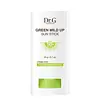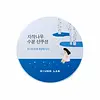What's inside
What's inside
 Key Ingredients
Key Ingredients

 Benefits
Benefits

 Concerns
Concerns

 Ingredients Side-by-side
Ingredients Side-by-side

Octyldodecanol
EmollientZinc Oxide
Cosmetic ColorantCetyl Ethylhexanoate
EmollientBenzotriazolyl Dodecyl P-Cresol
UV AbsorberCoco-Caprylate/Caprate
EmollientC12-15 Alkyl Benzoate
AntimicrobialIsopropyl Palmitate
EmollientAcrylates Copolymer
Butylene Glycol Dicaprylate/Dicaprate
EmollientSilica Silylate
EmollientDibutyl Lauroyl Glutamide
Skin ConditioningDibutyl Ethylhexanoyl Glutamide
Skin ConditioningCaprylic/Capric Triglyceride
MaskingButyloctyl Salicylate
Skin ConditioningDextrin Palmitate
EmulsifyingVinyldimethicone
Vinyl Dimethicone/Methicone Silsesquioxane Crosspolymer
Centella Asiatica Extract
CleansingMentha Viridis Extract
MaskingPinus Pinaster Bark Extract
AntioxidantCaesalpinia Spinosa Fruit Extract
Skin ProtectingKappaphycus Alvarezii Extract
Skin ConditioningBuddleja Officinalis Flower Extract
UV FilterCamellia Sinensis Leaf Extract
AntimicrobialGinkgo Biloba Leaf Extract
Skin ConditioningCamellia Japonica Leaf Extract
Skin ConditioningEruca Sativa Leaf Extract
Skin ConditioningTriticum Vulgare Sprout Extract
Skin ConditioningBrassica Oleracea Italica Sprout Extract
EmollientMedicago Sativa Extract
TonicGlyceryl Caprylate
EmollientTriethoxycaprylylsilane
Polyhydroxystearic Acid
EmulsifyingPolyglyceryl-6 Polyricinoleate
EmulsifyingTocopherol
AntioxidantWater
Skin Conditioning7-Dehydrocholesterol
Emulsion StabilisingEctoin
Skin ConditioningPropanediol
SolventButylene Glycol
HumectantLactobacillus Ferment
Skin Conditioning1,2-Hexanediol
Skin ConditioningParfum
MaskingOctyldodecanol, Zinc Oxide, Cetyl Ethylhexanoate, Benzotriazolyl Dodecyl P-Cresol, Coco-Caprylate/Caprate, C12-15 Alkyl Benzoate, Isopropyl Palmitate, Acrylates Copolymer, Butylene Glycol Dicaprylate/Dicaprate, Silica Silylate, Dibutyl Lauroyl Glutamide, Dibutyl Ethylhexanoyl Glutamide, Caprylic/Capric Triglyceride, Butyloctyl Salicylate, Dextrin Palmitate, Vinyldimethicone, Vinyl Dimethicone/Methicone Silsesquioxane Crosspolymer, Centella Asiatica Extract, Mentha Viridis Extract, Pinus Pinaster Bark Extract, Caesalpinia Spinosa Fruit Extract, Kappaphycus Alvarezii Extract, Buddleja Officinalis Flower Extract, Camellia Sinensis Leaf Extract, Ginkgo Biloba Leaf Extract, Camellia Japonica Leaf Extract, Eruca Sativa Leaf Extract, Triticum Vulgare Sprout Extract, Brassica Oleracea Italica Sprout Extract, Medicago Sativa Extract, Glyceryl Caprylate, Triethoxycaprylylsilane, Polyhydroxystearic Acid, Polyglyceryl-6 Polyricinoleate, Tocopherol, Water, 7-Dehydrocholesterol, Ectoin, Propanediol, Butylene Glycol, Lactobacillus Ferment, 1,2-Hexanediol, Parfum
Water
Skin ConditioningZinc Oxide
Cosmetic ColorantCaprylyl Methicone
Skin ConditioningMethyl Trimethicone
Skin ConditioningTitanium Dioxide
Cosmetic ColorantButylene Glycol Dicaprylate/Dicaprate
EmollientButyloctyl Salicylate
Skin ConditioningPolyglyceryl-4 Diisostearate/Polyhydroxystearate/Sebacate
EmulsifyingPropanediol
SolventGlycerin
HumectantMethyl Methacrylate Crosspolymer
Diisostearyl Malate
EmollientGlyceryl Glucoside
HumectantEthylhexylglycerin
Skin ConditioningLaminaria Japonica Extract
Skin ProtectingUlmus Davidiana Root Extract
Skin ConditioningAloe Barbadensis Leaf Extract
EmollientViola Mandshurica Flower Extract
AntioxidantDioscorea Japonica Root Extract
Skin ConditioningSodium Hyaluronate
HumectantHyaluronic Acid
HumectantDipotassium Glycyrrhizate
HumectantAllantoin
Skin ConditioningPortulaca Oleracea Extract
Skin ConditioningAdansonia Digitata Seed Extract
Skin ConditioningAscorbic Acid
AntioxidantButylene Glycol
HumectantDimer Dilinoleyl Dimer Dilinoleate
EmollientMagnesium Sulfate
Aluminum Hydroxide
EmollientDisteardimonium Hectorite
StabilisingStearic Acid
CleansingTriethoxycaprylylsilane
Polyglyceryl-6 Polyricinoleate
Emulsifying1,2-Hexanediol
Skin ConditioningDicaprylyl Carbonate
EmollientSorbitan Caprylate
EmulsifyingGlyceryl Caprylate
EmollientCaprylyl Glycol
EmollientTocopherol
AntioxidantWater, Zinc Oxide, Caprylyl Methicone, Methyl Trimethicone, Titanium Dioxide, Butylene Glycol Dicaprylate/Dicaprate, Butyloctyl Salicylate, Polyglyceryl-4 Diisostearate/Polyhydroxystearate/Sebacate, Propanediol, Glycerin, Methyl Methacrylate Crosspolymer, Diisostearyl Malate, Glyceryl Glucoside, Ethylhexylglycerin, Laminaria Japonica Extract, Ulmus Davidiana Root Extract, Aloe Barbadensis Leaf Extract, Viola Mandshurica Flower Extract, Dioscorea Japonica Root Extract, Sodium Hyaluronate, Hyaluronic Acid, Dipotassium Glycyrrhizate, Allantoin, Portulaca Oleracea Extract, Adansonia Digitata Seed Extract, Ascorbic Acid, Butylene Glycol, Dimer Dilinoleyl Dimer Dilinoleate, Magnesium Sulfate, Aluminum Hydroxide, Disteardimonium Hectorite, Stearic Acid, Triethoxycaprylylsilane, Polyglyceryl-6 Polyricinoleate, 1,2-Hexanediol, Dicaprylyl Carbonate, Sorbitan Caprylate, Glyceryl Caprylate, Caprylyl Glycol, Tocopherol
 Reviews
Reviews

Ingredients Explained
These ingredients are found in both products.
Ingredients higher up in an ingredient list are typically present in a larger amount.
1,2-Hexanediol is a synthetic liquid and another multi-functional powerhouse.
It is a:
- Humectant, drawing moisture into the skin
- Emollient, helping to soften skin
- Solvent, dispersing and stabilizing formulas
- Preservative booster, enhancing the antimicrobial activity of other preservatives
Butylene Glycol (or BG) is used within cosmetic products for a few different reasons:
Overall, Butylene Glycol is a safe and well-rounded ingredient that works well with other ingredients.
Though this ingredient works well with most skin types, some people with sensitive skin may experience a reaction such as allergic rashes, closed comedones, or itchiness.
Learn more about Butylene GlycolWe don't have a description for Butylene Glycol Dicaprylate/Dicaprate yet.
Butyloctyl Salicylate is a chemical UV filter structurally similar to octisalate. It is a photostabilizer, SPF booster, emollient and solvent. This ingredient helps evenly spread out ingredients.
According to a manufacturer, it is suitable for pairing with micro Titanium Dioxide, Zinc Oxide, and pigments.
Photostabilizers help stabilize UV-filters and prevents them from degrading quickly.
Learn more about Butyloctyl SalicylateGlyceryl Caprylate comes from glycerin and caprylic acid, a fatty acid from coconut. It has emollient and emulsifier properties.
As an emollient, it helps hydrate your skin. Emollients work by creating a barrier on your skin to trap moisture in, helping to keep your skin soft and smooth.
On the other hand, emulsifiers prevent ingredients (such as oil and water) from separating.
Learn more about Glyceryl CaprylatePolyglyceryl-6 Polyricinoleate isn't fungal acne safe.
Propanediol is an all-star ingredient. It softens, hydrates, and smooths the skin.
It’s often used to:
Propanediol is not likely to cause sensitivity and considered safe to use. It is derived from corn or petroleum with a clear color and no scent.
Learn more about PropanediolTocopherol (also known as Vitamin E) is a common antioxidant used to help protect the skin from free-radicals and strengthen the skin barrier. It's also fat soluble - this means our skin is great at absorbing it.
Vitamin E also helps keep your natural skin lipids healthy. Your lipid skin barrier naturally consists of lipids, ceramides, and fatty acids. Vitamin E offers extra protection for your skin’s lipid barrier, keeping your skin healthy and nourished.
Another benefit is a bit of UV protection. Vitamin E helps reduce the damage caused by UVB rays. (It should not replace your sunscreen). Combining it with Vitamin C can decrease sunburned cells and hyperpigmentation after UV exposure.
You might have noticed Vitamin E + C often paired together. This is because it is great at stabilizing Vitamin C. Using the two together helps increase the effectiveness of both ingredients.
There are often claims that Vitamin E can reduce/prevent scarring, but these claims haven't been confirmed by scientific research.
Learn more about TocopherolTriethoxycaprylylsilane is a silicone used to bind and stabilize ingredients.
As an emulsifier, it helps prevent ingredients from separating. This can help elongate the shelf life of products.
Triethoxycaprylylsilane is often used to coat mineral sunscreens ingredients to help give a better feel. It also helps reduce oxidative stress in sunscreens.
Learn more about TriethoxycaprylylsilaneWater. It's the most common cosmetic ingredient of all. You'll usually see it at the top of ingredient lists, meaning that it makes up the largest part of the product.
So why is it so popular? Water most often acts as a solvent - this means that it helps dissolve other ingredients into the formulation.
You'll also recognize water as that liquid we all need to stay alive. If you see this, drink a glass of water. Stay hydrated!
Learn more about WaterZinc Oxide is a mineral broad-spectrum UV filter; it is the broadest UVA and UVB reflector approved by the FDA. It also has skin protectant and skin soothing properties.
Zinc oxide is one of the most effective broad-spectrum UV filters. It protects against UVB, UVAII, and UVAI. In comparison to its counterpart titanium dioxide, zinc oxide provides uniform and extended UVA protection.
Another great benefit? This ingredient is highly photostable so it won't degrade easily under sunlight.
A common myth is that mineral UV filters are widely believed to primarily reflect UV light.
However, modern research shows titanium dioxide absorbs UV radiation like chemical filters (~95% absorption & 5% reflection).
Zinc oxide has great skin soothing properties so you'll likely find this in sunscreens formulated for sensitive skin or babies/children. It is unlikely to cause "eye sting" like other sunscreen ingredients.
Regulatory agencies consider zinc oxide to be non-toxic and safe. It has also been shown to not penetrate the skin.
Unfortunately, this ingredient does leave a visible white cast. This is why mineral sunscreens are often less cosmetically elegant than chemical or hybrid ones.
In cosmetics, zinc oxide can be found in both non-nano and nano-sized forms. The nano version is used to reduce white cast and improve the texture of sunscreen formulas.
There are ongoing concerns surrounding nano-zinc oxide's impact on marine ecosystems and whether it can be absorbed into skin.
Regarding marine ecosystems and coral reefs, there is no conclusive evidence that any form of zinc oxide (or any other sunscreen ingredients) will cause harm. The science is still developing but many consumers are keeping a close eye on this issue.
Please note, many destinations have reef-safety sunscreen rules. For instance, the U.S. Virgin Islands advises all visitors to use non-nano mineral sunscreens.
There has also been some stir about whether micronized or nano zinc oxide has potential photoxicity and absorption through the skin/lungs.
An in-vitro (done in a test tube or petri dish) study demonstrated micronized zinc oxide to have potential phototoxicity. There's no need to fret; the EU Commission's Scientific Committee on Consumer Safety has stated, "The relevance of these findings needs to be clarified by appropriate investigations in vivo." Or in other words, further studies done on living organisms are needed to prove this.
Current research shows zinc oxide nanoparticles do not penetrate intact or sunburned skin. They either remain on the surface or in the outermost layer of dead skin (stratum corneum).
Zinc oxide is one of only two classified mineral UV filters with titanium dioxide being the other one.
Fun fact: Zinc has been used throughout history as an ingredient in paint and medicine. An Indian text from 500BC is believed to list zinc oxide as a salve for open wound. The Ancient Greek physician Dioscorides has also mentioned the use of zinc as an ointment in 1AD.
Learn more about Zinc Oxide